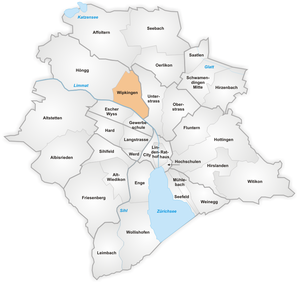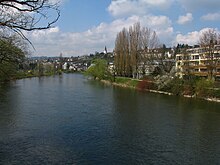Wipkingen
|
Wipkingen district of Zurich |
|
|---|---|
| Coordinates | 681.9 thousand / 249 660 |
| height | Ø 431 m |
| surface | 2.11 km² |
| Residents | 15,164 (December 31, 2015) |
| Population density | 7187 inhabitants / km² |
| BFS no. | 261-102 |
| Post Code | 8037 |
| Urban district | District 10 since 1893/1934 |
Wipkingen is a district of the city of Zurich . The formerly independent municipality Wipkingen was incorporated in 1893 and is today along with Hongg the circuit 10 .
coat of arms
- A black horseshoe in gold
history

The name Wipkingen goes back to the Alemannic founder of the settlement Wibicho . The place was first mentioned in a document in 881, when Emperor Karl the Fat gave the Fraumünster's fief to his loyal Wolfgrim. The place was previously called Wibichinga , from which Wipkingen developed. Even today, Wibichstrasse in the upper part of the quarter is reminiscent of Wibicho.
Incorporation
In 1893 the municipality of Wipkingen and ten other independent municipalities became part of the city of Zurich. The city and the new eleven municipalities were divided into five city districts (I to V). Wipkingen together with Oberstrass and Unterstrass formed the city district IV .
The division of the original five city districts was revised in 1913 and by dividing the city district III into three and dividing the city district V into two, eight new city districts (1 to 8) were formed. As a result, District IV was renumbered and Wipkingen was now part of City District 6 .
With the second incorporation in 1934, eight more municipalities were added to the city, which were combined in the new city districts 9 to 11, while the old city districts were left unchanged with two exceptions: the new municipality Witikon was assigned to the already existing district 7 when Wipkingen was the only one of the old communities that had to change its district and was assigned to the new district 10 together with Höngg .
Infrastructure
On the Waidberg , high above the center of Wipkingen, is the Waid City Hospital - one of two city hospitals in Zurich - which is responsible for supplying the north-west of the city.
The actual center of Wipkingen extends from Wipkingerplatz on the right bank of the Limmat ( Letten ) over Röschibachstrasse up to the north bridge, where the Wipkingen train station is located. The construction of the new Hardbrücke and the expansion of the same to the provisional west bypass (1982) have divided the quarter into two halves.
traffic
Today tram line 13 only touches the district on the south-eastern edge. Before the Hardbrücke was built, tram line 4 ran from Wipkingerplatz, which is still served by the 13 today, through Röschibachstrasse to the north bridge. The branch had to be abandoned because the four-lane Hardbrücke takes up the space where the wide curved track in Röschibachstrasse was.
The main development of the quarter is carried out by the trolleybus lines 33, 46 and 72 , which run on the main road axes (Rosengartenstrasse / Hardbrücke and Nordstrasse / Rotbuchstrasse).
The lodging offers with the station Wipkingen a SBB - stop at one of the oldest railway lines in Switzerland, in 1856 by the NOB opened railway line Zurich - Oerlikon (with continuation to Winterthur). However, the trains only drove past for the first 75 years - the station was only opened in 1932. Since the opening of the Weinberg tunnel, the station has only been served by the S24 trains of the Zurich S-Bahn . Until 1989, Wipkingen had a second station, Letten station on the border with Unterstrass , on the former Zurich – Stadelhofen – Rapperswil line. With the opening of the Hirschengraben tunnel , the railway line was lifted and the station closed; Since then, the area has been comparatively poorly developed by Zurich standards.
Due to the hillside location of Wipkingen, the main traffic axes run in an east-west direction. The volume of traffic is therefore high on the few main roads leading up the slope; These are the axes Kornhausbrücke -Rötelstrasse- Bucheggplatz on the eastern edge of the quarter and the so-called west bypass over Rosengartenstrasse, which massively polluted the quarter (as well as the Unterstrass, Hard and Wiedikon quarters) after its expansion in 1982 until 2009 and the quarter completely Splits. As a temporary measure , this western bypass connected the A1L , A1H / A3 and A3W motorway branches built into the city , because a bad planning from the 1950s provided for a link between three motorways in the middle of the Zurich Expressstrasse Y in the city, which was only partially implemented. When the Üetliberg tunnel and thus a motorway ring around the city were opened in 2009, the tracks on the western bypass were also reduced in Wipkingen in order to force through traffic onto the motorway ring.
Churches
In Wipkingen there are the following parishes, churches and church centers:

The Evangelical Reformed parish of Wipkingen has two churches:
- The Wipkingen church is clearly visible in the silhouette of the district on Wibichstrasse. It was built in 1908–1909 by Jacques Kehrer and Charles Conrad and replaced the previous church, which had to give way to the growing traffic of today's Rosengartenstrasse.
- The Letten church , which Max Aeschlimann and Armin Baumgartner built in the Landi style between 1954 and 1955, is located on Imfeldstrasse in the residential district of Letten .
- The Wipkingen parish hall , which was built by the architects Vogelsanger und Maurer in 1930–1932 and is considered to be the first high-rise in the city of Zurich, also belongs to the Reformed parish of Wipkingen . The center for migrant churches has also been located here since December 2008 .
The Roman Catholic Church is represented in the quarter with the parish Guthirt:
- The Guthirt Church was built in the years 1922–1923 by the architect and later city councilor Anton Higi (1885–1951) and is located at Guthirtstrasse 3. The bell specialist Stefan Mittl announced the bell of the Guthirt Church in the NZZ on July 6, 2007 Wipkingen together with another church as his favorite among the most melodious bells in the canton of Zurich.
The Greek Orthodox Church has its Zurich church in Wipkingen:
- The church of Agios Dimitrios is located in the residential area of Letten and is on Rousseaustrasse. It was built in the years 1983–1985 by the architect Marcel Ferrier and due to objections it was not allowed to conform to the traditional image of an Orthodox church.
Recreational areas
The city of Zurich upgraded the area on the banks of the Limmat between Wipkingerbrücke and Ampèrestrasse to a city park, which was officially inaugurated on June 18, 2004 as Kattunpark (from French coton = cotton , based on the former cotton industry in the district). The name proposed by the street naming commission was rejected by the population, which is why the park has been officially called Wipkingerpark since December 15, 2004 . It is used a lot in summer and extends the GZ community center.
From Waidberg , with the exception of city districts 11 and 12, you can see the whole city towards the lake and mountains.
literature
- Martin Bürlimann, Kurt Gammeter: Café Letten - A reading book. A journey through time through the Latvian. Wibichinga, Zurich 2015, ISBN 3-9523149-3-5 .
- Presidential Department of the City of Zurich, Statistics City of Zurich: Quartierspiegel Wipkingen. Zurich 2015 ( read online ).
- Martin Bürlimann, Kurt Gammeter: Bells ringing: From Kilchli to Wipkingen Church. Wibichinga, Zurich 2009, ISBN 978-3-9523149-2-0 .
- Annabeth Schallenberg: Pictures of Life: Encounters in the Käferberg. Wibichinga, Zurich 2007, ISBN 978-3-9523149-1-3 .
- Martin Bürlimann, Kurt Gammeter: Wipkingen: From the village to the quarter. Wibichinga, Zurich 2006, ISBN 3-9523149-0-0 .
- Ursina Jakob, Daniel Kurz: Habitat Wipkingen: History of a Zurich City Quarter 1893–1993. Chronos , Zurich 1993, ISBN 3-905311-19-4 ( online ).
- Franz Bösch: Wipkingen: His churches over time. Roman-Catholic rectory Guthirt, Zurich 1983.
- Jakob Frei: Wipkingen then and now: A quarter chronicle. Non-profit organization Wipkingen, Zurich 1981 ( online ).
- Emil Siegfried: Chats about Alt-Wipkingen . Self-published, Zurich 1942.
- Conrad Escher, Rudolf Wachter: Chronicle of the community Wipkingen. Orell Füssli , Zurich 1917.
Web links
- District association Wipkingen
- Martin Illi: Wipkingen. In: Historical Lexicon of Switzerland .
Individual evidence
- ↑ The railway cut in history (PDF; 77 kB)
- ↑ Zurich West Bypass: The preliminary correction of a bad planning - Invented over 50 years ago, the street Ypsilon shapes Zurich's traffic policy to this day. In: Neue Zürcher Zeitung . April 20, 2009.
- ↑ See the following: Robert Schönbächler: Churches and places of worship in the city of Zurich. New Year's Gazette Industriequartier / Aussersihl. Zurich 2013, pp. 105–109







